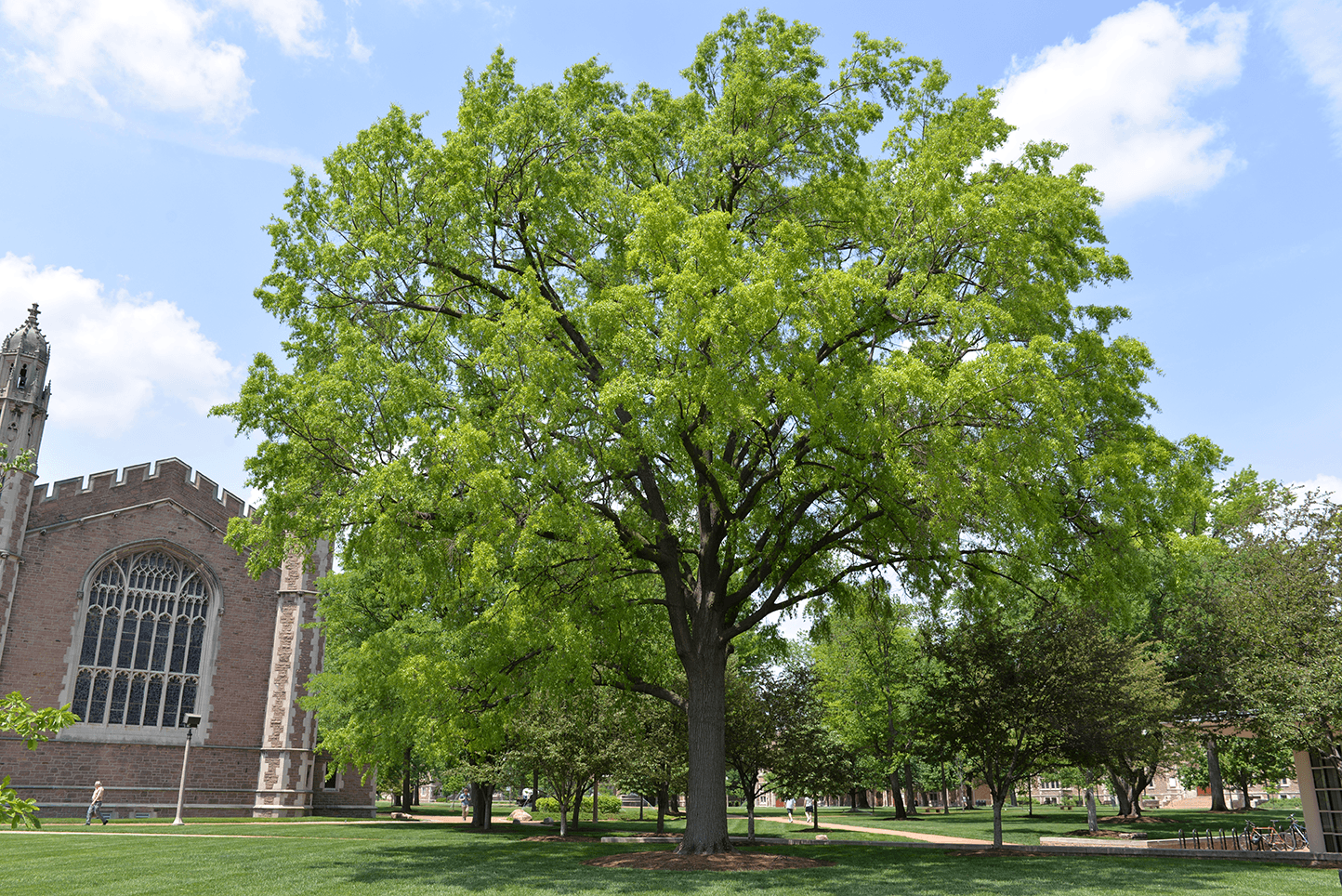Willow Oak
Arbor Walk #22, Treekeeper ID #1513

This large native tree has a unique form compared to most other oaks, with one of the smallest leaves of any native oak and a simple, unlobed, elliptic leaf shape. It is considered a medium to large oak, growing up to 80 feet, and is native to the Southeast United States, including the Bootheel region of Missouri that makes up the northwest corner of the Willow Oak’s range. In Missouri, the Willow Oak is generally found in wetter areas bordering swamps, or poorly drained lowlands. Despite their quick growth rate, these oaks are not common in Missouri given the reduction of suitable habitat within the Bootheel.
The Willow Oak is a member of the subgenus of red oaks. These oaks are distinguishable from other oaks from their awns (soft bristles) at the ends of leaf lobes, their orange hairs on the leaf underside at vein intersections, and their dark, ridged bark. For the Willow Oak, the most noticeable of these features is the bristle at the leaf tip, instead of at the lobe tips.


GPS Coordinates
N/A
Percent Concrete
N/A
Distance to Buildings
| Year | Close Building #1 | Close Building #2 | Close Building #3 |
|---|---|---|---|
| 2024 |
Distance to Other Species
| Year | Close Species #1 | Close Species # 2 | Close Species # 3 |
|---|---|---|---|
| 2024 |
Standard Measurements
| Year | Height (m) | DBH (cm) | Caliper (m) | Crown Diameter N-S (m) | Crown Diameter E-W (m) | Average Crown Diameter (m) |
|---|---|---|---|---|---|---|
| 2020 | 22.5586 | 88.85 | N/A | 24.43 | 22.45 | 23.44 |
| 2023 | 23.28 | 93 | N/A | 24.3 | 20.8 | 22.55 |
| 2024 | 26.75 | 93.7 | N/A | 24.75 | 24.01 | 24.38 |
Nests and Pests
| Year | Description |
|---|---|
| 2020 | 4 webworm/tentworm nests 1 squirrel nest 1 old wound that may be a canker Large spots of grey lichen, with some moss, green algae, and at least two other green lichen varieties all present on the trunk bark. |
Leaf Identification
The leaves of the Willow Oak are simple (no leaflets), alternately arranged on the stem, pinnately veined, and unlobed. The leaves are glossy above, 2-5″ in length, narrowly elliptic, and often slightly bent along the midvein. The leaves have an awn (bristle tip) at their tips.
Twig and Bud Identification
The twigs are gray-brown, smooth, not zig zag, and relatively thin. The buds are pointed, ovoid, and reddish-brown. The terminal buds are clustered.
Bark Identification
The bark is gray, with shallow vertical ridges and furrows.
Fruit Identification
The fruit of the Willow Oak is an acorn. The Willow Oak acorn is nearly globular, with a shallow cup of hairy scales and often, a striped nut. The nut can reach 3/4″ in diameter, and matures in the fall.
Flower Identification
The flowers of the Willow Oak are monoecious; both male and female flowers exist separately but on the same tree. The staminate (male) flowers are greenish-yellow catkins (long, slender unisexual flower clusters) that hang down from the branch. The pistillate (female) flowers are much smaller, pink-tinged green clusters that cling to the stem. The flowers bloom in spring.
Oak ID Tips
- The only other Missouri native oak besides the Willow Oak with an unlobed, untoothed margin is the Shingle Oak. The Willow Oak can be distinguished by its smaller and much more narrowly elliptic leaf. The Shingle Oak is wider and densely hairy on its underside.
- The Willow Oak is similar to other Southern oaks, like the Laurel Oak or Southern Live Oak, among others. The Willow Oak has the distinguishing combination of bristle-tipped leaves (thus, a red oak), narrowly elliptic leaves, tufted vein axils, and a relatively large size tree.







